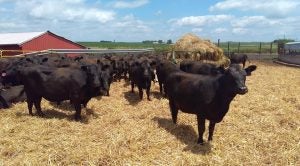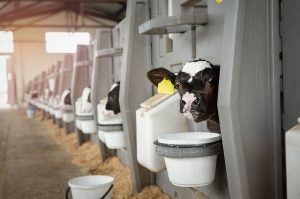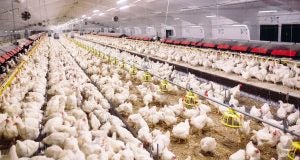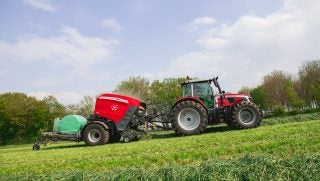There have always been a lot of concerns and myths related to animal agriculture’s effect on climate change, greenhouse gas emissions, water use, and overall environmental impact. Some people claim that animal agriculture should be eliminated in order to solve the climate crisis and reduce greenhouse gas emissions. Animal agriculture agrees with the rest of the world that we can always be more sustainable. That’s why animal ag has repeatedly show a commitment to improving sustainability by reducing greenhouse gas emissions, water use, land use, waste and by improving efficiency.
First off, sustainability is the ability to meet the needs of the present without compromising the ability of future generations to meet their needs. Sustainability is more than just considering environmental impacts, it also includes nutritional and economic foundations.
Let’s get one thing straight, animal agriculture is not a large source of greenhouse gas emissions. According to the Environmental Protection Agency, livestock production accounts for only 4 percent of U.S. GHG emissions. This isn’t very much when compared to the 28 percent of emissions caused by transportation.
In fact, eliminating all livestock from the agriculture industry would reduce greenhouse gas emissions only by 2.6 percent to 2.9 percent in the United States. This is clearly a small impact for an industry that feeds and supplies so many people. This would also create a large nutritional gap for consumers.

The animal agriculture industry is also working aggressively to improve its environmental impact. One example of this is the dairy industry. To produce the same amount of milk from 1944 to 2007, the dairy industry uses 21 percent the number of animals, 23 percent of feedstuffs, 35 percent the water, and only 10 percent of the land. The environmental impact of producing the same amount of milk in 2007 was only 37 percent of the impact in 1944.
And this kind of thing has happened in every sector of animal agriculture.
Other examples of animal ag improving its environmental impact include the poultry industry and the beef industry. The poultry industry has decreased its climate impact by 36 percent from 1965 to 2010. The beef industry has decreased its carbon footprint by 16.3 percent for every billion kilograms of beef produced in 2007 compared to 1977.
Animal agriculture has decreased its environmental impact by using responsible management practices, utilizing new technologies, implementing farmer pledges, and by following expert guidelines. Advances in nutrition and genetics also contribute to decreasing this environmental impact.
Here’s how different areas of animal ag have improved their environmental impact:
Dairy
The dairy industry has found many ways to decrease its environmental impact. One example of this is the National Dairy Farmers Assuring Responsible Management (FARM) Program, which provides quality assurance to consumers. The FARM Program also provides environmental stewardship resources to farmers, and over 99 percent of the U.S. milk supply comes from farms that participate in this program.
The dairy industry has also adopted advanced technology such as anaerobic digesters to convert manure into usable energy.

Beef
The beef industry is also working to improve its environmental impact. One reason beef cattle are more sustainable than people realize is because cattle are “up cyclers.” This means that they graze on land that is not suitable to grow crops on and they consume byproducts like distiller’s grains, which are leftover from biofuel production. Cattle convert things that are indigestible by humans into nutrients that we can use, like protein.
The United States has also made strides in production efficiency — here, we produce 18 percent of the world’s beef with only 6 percent of the world’s cattle.
Pork
The pork industry has also been working hard to achieve sustainability goals. One recent advancement is the efficiency of pork production. Today it takes five hogs to produce the same amount of meat that required eight hogs in 1959. Recently, the pork industry committed to reducing greenhouse gas emissions by 40 percent from a 2015 baseline by 2030.
Poultry
Poultry is another sector of animal agriculture working to reduce its environmental impact. Studies have shown that using genetic selection can decrease the environmental impact of poultry production without a negative impact on growth, body composition, or meat quality. Improvements in genetics have already decreased the production time for chicken and turkey, meaning that fewer resources are used to produce the same amount of meat.

Egg Production
Egg production has decreased its environmental impact by 71 percent, decreased greenhouse gas emissions by 63 percent, and has a 13 percent lower cumulative energy demand in 2010 than in 1960. Improvements in housing and waste management are some of the reasons for this. Other causes of these improvements are advanced genetics and improved hen nutrition.
Sheep and Lamb
Sheep and lamb production has also increased its sustainability. Sheep are used to control weeds. This can help prevent wildfires, improve land quality, promote healthy forests, and even prevent weeds from growing in yards and vineyards. Wool from sheep provides clothing, blankets, home insulation, carpet fibers and various other products. Wool is a sustainable fabric because wool garments can have longer lifespans, are washed less often, are biodegradable and are very renewable because sheep need to be sheared yearly.
Animal ag is also into recycling. Byproducts are what is leftover after producing another product. One example is distiller’s grains, which are a byproduct of producing ethanol. These grains and other byproducts of human food production such as almond hulls and citrus peels can be fed to livestock. This helps decrease food waste. In fact, 40 percent of animal feed ingredients are byproducts.
» Related reading: The nutritional and economic sustainability of animal ag
To further demonstrate animal ag’s commitment to improving, most livestock production industries have set industry-wide goals. Many of these goals include maximizing recycling, optimizing water use, and even complete greenhouse gas neutrality set for a target year.
Advancements in genetics, animal nutrition and feeding, and in management practices have helped livestock production to become much more environmentally sustainable. Future advances in science and technology will only help the agriculture industry to keep improving!
Michelle Miller, the “Farm Babe,” is an internationally recognized keynote speaker, writer, and social media influencer and travels full time to advocate for agriculture. She comes from an Iowa-based row crop and livestock farming background and now resides on a timber farm in North Central Florida.



